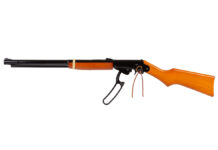Chuck Norris doesn’t sleep. He waits. But for the regular Joe, being awakened from a deep sleep by a bump in the night can be a brown-pants-inducing experience. At least if you’re in your home, you’re familiar with your surroundings and should be able to navigate through it in complete darkness. You know the floor plan. You know all the avenues of approach. And, with a little prior planning and practice, you have an advantageous position where you can defend yourself and your loved ones from any attempted assault.
It’s one thing to be safe and secure in our homes. It’s quite another to maintain that same level of protection when we’re sleeping under the stars, far from civilization. Whether we’re enjoying all that Mother Nature has to offer on a relaxing camping trip or searching for sanctuary in the midst of a crisis evacuation, dusk brings on a whole new set of challenges when there are no walls and roof around you. How do we guard against those ominous sounds of creatures roaming the wilderness, looking for easy prey? How can we know the difference between man and animal?
Several factors should be considered when selecting an appropriate location to set up an overnight campsite, but that’s the topic for another article. For our purposes, we will assume we’ve selected a good location to make camp and have now progressed to the point of trying to establish some level of security.

One of the most challenging aspects of setting up perimeter defenses is restricting access to your base camp. The feeling of freedom and open air that campers love also works against us when it comes to protecting our campsite from unwanted wanderers or outright intruders. While selecting a good location for the campsite is a critical first step, it’s only one step in the larger defense-in-depth strategy.
The next step is to create an early warning system for when someone or something approaches our location. For those who don’t have a lot of wilderness time under their belt, you’ll be shocked to find how noisy it is at night, as all manner of creatures venture out under the cover of darkness for their evening meal. Depending on the location and time of year, the noise can really be quite loud. Anything moving around at night can potentially have plenty of background noise to mask its movement. Additionally, if one is bedded down in a wooded area, one will notice that noise tends to ricochet off the trees, making it difficult to localize and pinpoint the source. Do not fall into the false mindset that any intruder wandering into the campsite will make enough noise to wake you and give you time to determine their intentions. Creating an early warning system will ensure you have some measure of advanced notice to an intruder, be they two- or four-legged.

Early warning systems can be quite simple or very complex, but since most outdoorsmen take a minimalistic approach to travelling in nature, a simple security solution seems the best choice. Let’s look at three simple options for securing your campsite location.
Table of Contents
The Old Tin-Can Trick

If you’re a fan of AMC’s The Walking Dead TV show, then you’ve seen this zombie security system quite often. It doesn’t get any simpler than a length of string, a few empty soup cans, and some small rocks.
Cut an entrance and an exit hole in the can just small enough to lace through the string. Partially cut the lid just wide enough to add a few rocks inside the can, then press the lid shut. Lace the string through several cans, leaving enough string on either end to tie off the ends to make a string barrier. Make the barrier long enough to cover the width of the access path you want to secure. Tie off the ends of the barrier with enough tension to pull the system relatively tight and level across the ground.
A height of two to three feet off the ground is a good all-around height to protect against moderately sized animals and low enough that under the cover of darkness a person wandering around may not notice the alarm and set it off.

Tip: If this type of setup appeals to you, consider getting a bag of marbles to use in the cans. They roll around much easier and seem to make a more audible alarm when banging around inside the cans. Additionally, a good length of strong fishing line will work better as a string than 550 paracord, and it weighs next to nothing.
The Modified Window/Door Alarm

While the marble-in-a-can method might work for you minimalists, the MacGyver fans are going to want something a little more “techie” for their campsite. Fortunately, your favorite local hardware store or online shop should have just the thing: small window/door security alarms. Modifying their use for campsite security is only limited by your imagination.

One simple option is to purchase a doorstop alarm. These alarms function by placing them directly behind a door. They are shaped similar to a doorstop with a ramped area that allows the door to slide over the ramp, effectively pressing the ramp down into the unit. When the ramp is depressed enough, a loud audible alarm is triggered.
A simple method for employing their use is to create a tripwire across an access path. Tie off one end of the fishing line to a tree or other secure object. String the wire across the path and tie the other end of the string off to a short length of stick. Find any object with some mass such as a small log or rock. Prop the object up with the stick, ensuring the line is taut across the path. Place the doorstop alarm under the object positioned in such a way that when the trip line is pulled, the stick is pulled out from under the object, allowing the object to fall on the doorstop, setting off the audible alarm.
Tip: Having four or five units in your pack gives you another simple but effective way to secure multiple access paths to your campsite. Piercing alarms going off simultaneously will be loud enough to scare away all but the most determined predators.
The CAPSS3 Option

For those who take their campsite security a little more seriously, look no further than Brite-Strike Technologies, which offers a host of handheld and weapon-mounted lights for combative applications. Brite-Strike has also introduced several products for the perimeter alarm market.
The All Purpose Adhesive Light Strips (APALS) are basically solar-powered light sticks that provide about 40 lumens of green or red light for more than 12 hours on a single charge. Smaller than your standard smartphone, these units are lightweight alternatives to chemical light sticks and last twice as long. To provide the same amount of illumination as the APALS for one year, a user would need to purchase 730 chem light sticks at an average cost of $1,200. One APALS retails for about $20. This is quite a no-brainer for those looking for some late-night campsite illumination options that don’t include packing around 15 or 20 chem lights or battery-powered lanterns.

Another innovative Brite-Strike product is the Camp Alert Perimeter Security System and Survival Signaling System (CAPSS3). The CAPSS3 is a lightweight and compact multifunction unit that offers both security and signaling capabilities for the outdoor enthusiast. The CAPSS3 unit comprises of a 135-decibel audible alarm unit that is triggered by a built-in metallic trip rod. Pulling the rod out of the recess in the unit triggers the alarm.
A small LED red dot is built into the side of the unit that acts as both a visual alarm and provides enough red light at night to read maps or other documents. A larger blue LED light is built into the unit along the length of the CAPSS3. It has the dual function of acting as a visual alarm and offering enough blue light to signal rescuers or to help mark one’s location for airborne search-and-rescue operations. A slide button is located on the face of the unit to allow the lights to be used for reading or signaling. Plus there’s a strobe function that can go off in conjunction with the audible alarm.

A small key ring is attached to the triggering rod to provide several tripwire attachment options, and each CAPSS3 unit includes two 10-meter-long clear monofilament lines for use as a nearly invisible tripwire. Additionally, the unit comes with a small section of heavy-duty 3M double-sided adhesive tape for attaching the CAPSS3 unit to any surface, such as a tree or a rock. A few small nylon zip ties can also be used to stick the unit onto odd-shaped surfaces. The CAPSS3 survival signaling system has an MSRP of $40 — but wait, there’s more! Each CAPSS3 system also includes two blue APALS at no extra cost.
Tip: The unit is slightly smaller than a deck of cards and weighs only a few ounces, so pack several units in your day pack or bug-out bag. They certainly won’t hurt your back after a long day of hiking yet provide multiple points of security.
Layered Defense

As you can see, each type of early warning system has pros and cons, but there are certainly more benefits than negatives. Plus, they’re all relatively affordable and easy to set up. If you’re a minimalistic prepper who needs to stay light and mobile, picking any one of these options can give you peace of mind if you’re forced away from your neighborhood and into unknown territory. For those who like to spend a lot of time with Mother Nature but take their personal security seriously (or perhaps their zombie defenses a little too seriously), you can always opt to layer your defenses by using a combination of these systems.
Because not all of us have Chuck Norris-like instincts, having some sort of reliable perimeter security system is the secret to getting a good night’s rest when sleeping under the stars. With the knowledge that you’ll be alerted if a predator — man or beast — enters your campsite, you’ll be ready for anything that goes bump in the night.











































